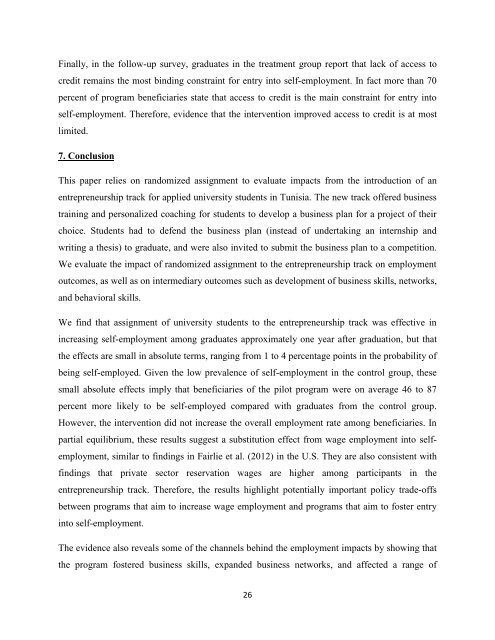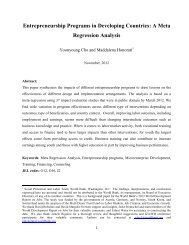Download - Youth Economic Opportunities
Download - Youth Economic Opportunities
Download - Youth Economic Opportunities
You also want an ePaper? Increase the reach of your titles
YUMPU automatically turns print PDFs into web optimized ePapers that Google loves.
Finally, in the follow-up survey, graduates in the treatment group report that lack of access tocredit remains the most binding constraint for entry into self-employment. In fact more than 70percent of program beneficiaries state that access to credit is the main constraint for entry intoself-employment. Therefore, evidence that the intervention improved access to credit is at mostlimited.7. ConclusionThis paper relies on randomized assignment to evaluate impacts from the introduction of anentrepreneurship track for applied university students in Tunisia. The new track offered businesstraining and personalized coaching for students to develop a business plan for a project of theirchoice. Students had to defend the business plan (instead of undertaking an internship andwriting a thesis) to graduate, and were also invited to submit the business plan to a competition.We evaluate the impact of randomized assignment to the entrepreneurship track on employmentoutcomes, as well as on intermediary outcomes such as development of business skills, networks,and behavioral skills.We find that assignment of university students to the entrepreneurship track was effective inincreasing self-employment among graduates approximately one year after graduation, but thatthe effects are small in absolute terms, ranging from 1 to 4 percentage points in the probability ofbeing self-employed. Given the low prevalence of self-employment in the control group, thesesmall absolute effects imply that beneficiaries of the pilot program were on average 46 to 87percent more likely to be self-employed compared with graduates from the control group.However, the intervention did not increase the overall employment rate among beneficiaries. Inpartial equilibrium, these results suggest a substitution effect from wage employment into selfemployment,similar to findings in Fairlie et al. (2012) in the U.S. They are also consistent withfindings that private sector reservation wages are higher among participants in theentrepreneurship track. Therefore, the results highlight potentially important policy trade-offsbetween programs that aim to increase wage employment and programs that aim to foster entryinto self-employment.The evidence also reveals some of the channels behind the employment impacts by showing thatthe program fostered business skills, expanded business networks, and affected a range of26
















